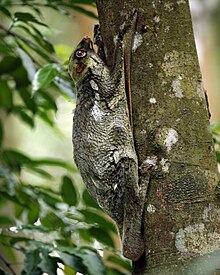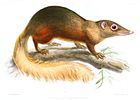| Primatomorpha Temporal range: Late Cretaceous–Holocene, 66–0 Ma PreꞒ Ꞓ O S D C P T J K Pg N | |
|---|---|

| |

| |
| Scientific classification | |
| Domain: | Eukaryota |
| Kingdom: | Animalia |
| Phylum: | Chordata |
| Class: | Mammalia |
| Magnorder: | Boreoeutheria |
| Superorder: | Euarchontoglires |
| Grandorder: | Euarchonta |
| Mirorder: | Primatomorpha Beard, 1991 |
| Orders | |
| |
Primatomorpha is a proposed mirorder of mammals containing the orders Dermoptera (or colugos) and Primates. Primatomorpha is sister to Scandentia, together forming the Euarchonta.
The term "Primatomorpha" first appeared in the general scientific literature in 1991 (K.C. Beard) and 1992 (Kalandadze, Rautian). Major DNA sequence analyses of predominantly nuclear sequences (Murphy et al., 2001) support the Euarchonta hypothesis, while a major study investigating mitochondrial sequences supports a different tree topology (Arnason et al., 2002). A study investigating retrotransposon presence/absence data has claimed strong support for Euarchonta (Kriegs et al., 2007). Some interpretations of the molecular data link Primates and Dermoptera in a clade (mirorder) known as Primatomorpha, which is the sister of Scandentia. Primates probably split from the Dermoptera sister group 79.6 million years ago during the Cretaceous.
Other interpretations link the Dermoptera and Scandentia together in a group called Sundatheria as the sister group of the primates. Some recent studies place Scandentia as sister of the Glires, invalidating Euarchonta.
Taxonomy
| Euarchontoglires |
| ||||||||||||||||||||||||||||||||||||||||||||||||
References
- "Primatomorpha". Paleobiology Database.
- ^ Zhang ML, Li ML, Ayoola AO, Murphy RW, Wu DD, Shao Y (November 2019). "Conserved sequences identify the closest living relatives of primates". Zoological Research. 40 (6): 532–540. doi:10.24272/j.issn.2095-8137.2019.057. PMC 6822925. PMID 31393097.
- Collectif (1991). Coppens Y, Senut B (eds.). Origine(s) de la bipédie chez les hominidés. CNRS Éditions (réédition numérique FeniXX). ISBN 978-2-271-10666-7.
- Wilson Mantilla, G. P.; Chester, S. G. B.; Clemens, W. A.; Moore, J. R.; Sprain, C. J.; Hovatter, B. T.; Mitchell, W. S.; Mans, W. W.; Mundil, R.; Renne, P. R. (2021). "Earliest Palaeocene purgatoriids and the initial radiation of stem primates". Royal Society Open Science. 8 (2): rsos.210050, 210050. Bibcode:2021RSOS....810050W. doi:10.1098/rsos.210050. PMC 8074693. PMID 33972886.
- Esselstyn JA, Oliveros CH, Swanson MT, Faircloth BC (September 2017). "Investigating Difficult Nodes in the Placental Mammal Tree with Expanded Taxon Sampling and Thousands of Ultraconserved Elements". Genome Biology and Evolution. 9 (9): 2308–2321. doi:10.1093/gbe/evx168. PMC 5604124. PMID 28934378.
- O'Leary MA, Bloch JI, Flynn JJ, Gaudin TJ, Giallombardo A, Giannini NP, et al. (February 2013). "The placental mammal ancestor and the post-K-Pg radiation of placentals". Science. 339 (6120): 662–7. Bibcode:2013Sci...339..662O. doi:10.1126/science.1229237. hdl:11336/7302. PMID 23393258. S2CID 206544776.
- Wilford JN (7 February 2013). "Rat-Size Ancestor Said to Link Man and Beast". New York Times. Retrieved 9 February 2013.
- Meredith RW, Janečka JE, Gatesy J, Ryder OA, Fisher CA, Teeling EC, et al. (October 2011). "Impacts of the Cretaceous Terrestrial Revolution and KPg extinction on mammal diversification". Science. 334 (6055): 521–4. Bibcode:2011Sci...334..521M. doi:10.1126/science.1211028. PMID 21940861. S2CID 38120449.
- Zhou X, Sun F, Xu S, Yang G, Li M (March 2015). "The position of tree shrews in the mammalian tree: Comparing multi-gene analyses with phylogenomic results leaves monophyly of Euarchonta doubtful". Integrative Zoology. 10 (2): 186–98. doi:10.1111/1749-4877.12116. PMID 25311886.
Further reading
- Beard KC (1991). "Vertical postures and climbing in the morphotype of Primatomorpha: Implications for locomotor evolution in primate history". Origine(s) de la Bipedie chez les Hominides. Cahiers de Paleoanthropologie. Paris: Editions du CNRS. pp. 79–87. ISBN 9782222046028. OCLC 636661230.
- Janecka JE, Miller W, Pringle TH, Wiens F, Zitzmann A, Helgen KM, Springer MS, Murphy WJ (November 2007). "Molecular and genomic data identify the closest living relative of primates". Science. 318 (5851): 792–4. Bibcode:2007Sci...318..792J. doi:10.1126/science.1147555. PMID 17975064. S2CID 12251814.
- Goodman M, Czelusniak J, Page S, Meireles CM (2001). "Where DNA Sequences Place Homo sapiens in a Phylogenetic Classification of Primates". In Tobias PV, Raath MA, Moggi-Cecchi J, Doyle GA (eds.). Humanity from African naissance to coming millennia : colloquia in human biology and paleoanthropology. Firenze: Firenze University Press. ISBN 978-88-8453-003-5.
- Kriegs JO, Churakov G, Jurka J, Brosius J, Schmitz J (April 2007). "Evolutionary history of 7SL RNA-derived SINEs in Supraprimates". Trends in Genetics. 23 (4): 158–61. doi:10.1016/j.tig.2007.02.002. PMID 17307271. (PDF version)
- Arnason U, Adegoke JA, Bodin K, Born EW, Esa YB, Gullberg A, Nilsson M, Short RV, Xu X, Janke A (June 2002). "Mammalian mitogenomic relationships and the root of the eutherian tree". Proceedings of the National Academy of Sciences of the United States of America. 99 (12): 8151–6. Bibcode:2002PNAS...99.8151A. doi:10.1073/pnas.102164299. PMC 123036. PMID 12034869.
- Murphy WJ, Eizirik E, Johnson WE, Zhang YP, Ryder OA, O'Brien SJ (February 2001). "Molecular phylogenetics and the origins of placental mammals". Nature. 409 (6820): 614–8. Bibcode:2001Natur.409..614M. doi:10.1038/35054550. PMID 11214319. S2CID 4373847.
| Euarchontoglires | |||||||||||||||||||||||||||||||||||||||||
|---|---|---|---|---|---|---|---|---|---|---|---|---|---|---|---|---|---|---|---|---|---|---|---|---|---|---|---|---|---|---|---|---|---|---|---|---|---|---|---|---|---|
| |||||||||||||||||||||||||||||||||||||||||
| |||||||||||||||||||||||||||||||||||||||||
| |||||||||||||||||||||||||||||||||||||||||
| Taxon identifiers | |
|---|---|
| Primatomorpha | |
This article about a mammal is a stub. You can help Misplaced Pages by expanding it. |





